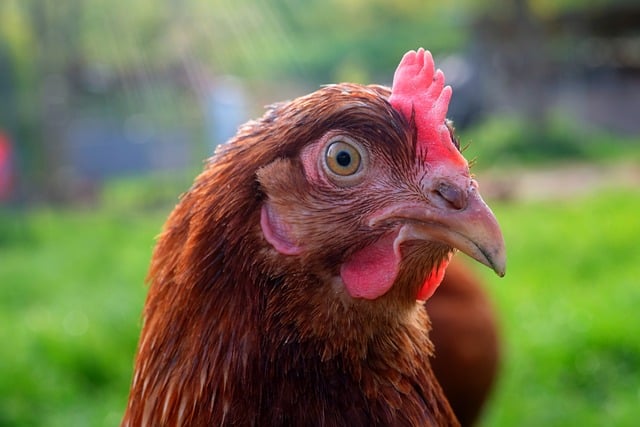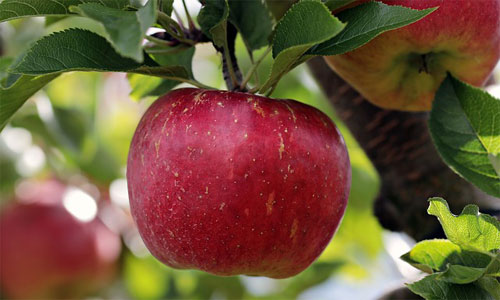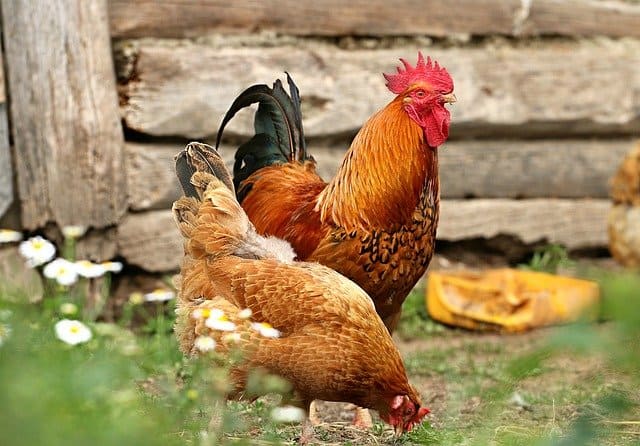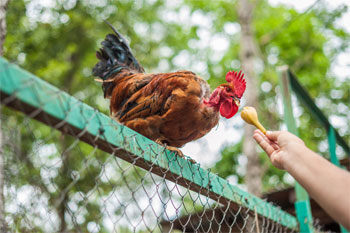A comb is the fleshy part on top of the chicken’s head. It is commonly bright red, but it may be purple or even black, depending. Structurally, combs are made of collage fibers that are meant to help the bird regulate body temperature.
In this manner, the comb functions as some sort of head bank to help store and release body heat based on the prevailing environmental conditions. Warmer chickens tend to have larger combs because their blood is pumping faster to release excess heat.
Besides thermoregulation, a comb is a symbol of status among the flock. Even more importantly, it can reveal a lot concerning the health condition of the chicken.
As we said earlier, the combo is usually vibrant red. Any condition that interferes with the normal color saturation of this part is abnormal. You might then ask, Why is my chicken’s comb pale? We will answer the question in this post.
Contents
What Influences the Color of the Chicken’s Comb?
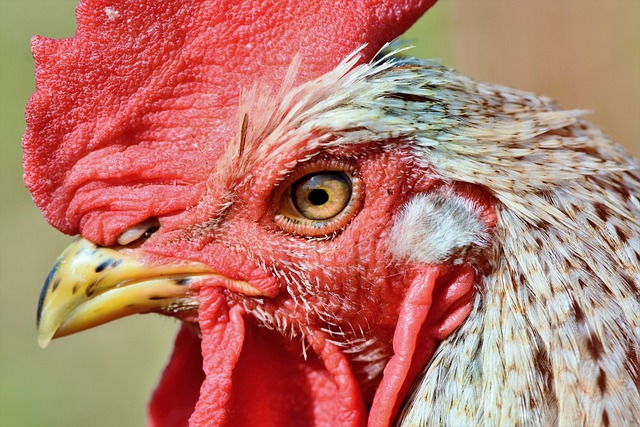
The color of a chicken’s comb can be influenced by various factors, including genetics, health, age, environment, and hormonal changes. Here are some key factors that can affect the color of a chicken’s comb:
Breed and Genetics
Different chicken breeds have distinct comb colors and shapes. Some breeds naturally have red combs, while others may have a lighter or darker shade. Genetic factors play a significant role in determining the natural color variation in combs.
Health and Well-being
A healthy chicken typically has a vibrant and richly colored comb. Any health issues or imbalances can affect blood circulation and oxygenation, resulting in a paler comb color. As mentioned earlier, anemia, poor nutrition, respiratory diseases, and blood parasites can contribute to a pale complexion.
Hormonal Changes
Hormonal fluctuations during a chicken’s life cycle can influence comb color. For example, in laying hens, the comb may become brighter and more vibrant when they are at the peak of their egg-laying cycle due to increased estrogen levels.
Maturity and Age
Young chicks often have pale or pinkish combs that gradually darken as they mature. The comb color can deepen as the bird reaches sexual maturity and develops secondary sexual characteristics.
Environmental Factors
Extreme temperatures, especially heat stress, can cause blood vessels in the comb to dilate, resulting in a brighter or redder comb color. Conversely, cold weather can cause temporary paleness due to the constriction of blood vessels.
Pigmentation and Sun Exposure
Sunlight exposure can influence the pigmentation of a chicken’s comb. Sunlight stimulates the production of pigments, leading to a darker comb color. Lack of exposure to natural sunlight may result in paler combs.
It’s important to observe any sudden or significant changes in a chicken’s comb color, as it can be a valuable indicator of its overall health. If you notice abnormal or persistent changes, consulting a veterinarian or poultry specialist is advisable for a proper diagnosis and appropriate treatment.
Top of Form
Causes Of Pale Comb in Chicken
A pale comb in chickens can be indicative of several potential causes. The comb is the fleshy, red structure on top of a chicken’s head, and its color and appearance can provide valuable information about the bird’s health. Here are some possible causes of a pale comb in chickens:
Anemia
A pale comb can be a sign of anemia, which occurs when the chicken has a low red blood cell count or insufficient hemoglobin. Anemia can result from various factors, including blood loss, nutritional deficiencies (such as iron deficiency), internal parasites (like worms), or certain diseases.
Poor Nutrition
Inadequate nutrition, specifically a lack of essential vitamins and minerals, can lead to a pale complexion. Chickens require a balanced diet with sufficient amounts of vitamins, minerals, and protein to maintain their health and vibrant comb color.
Heat Stress
Extreme heat or prolonged exposure to high temperatures can cause heat stress in chickens. As a result, blood vessels in the comb may dilate, leading to a pale appearance. Heat stress can be dangerous for chickens and may also manifest in other symptoms like panting, lethargy, and reduced egg production.
Respiratory Diseases
Some respiratory infections or diseases in chickens, such as infectious bronchitis, can affect blood oxygenation and circulation, resulting in a pale comb. Respiratory issues can be caused by viruses, bacteria, or environmental factors, and they often present with additional symptoms like coughing, sneezing, nasal discharge, and difficulty breathing.
Blood Parasites
Certain blood-borne parasites, such as mites or lice, can infest chickens and cause anemia. These parasites feed on the bird’s blood, leading to blood loss and subsequent paleness in the comb.
Chronic Illnesses
Chronic diseases or underlying health conditions, such as kidney disease or liver dysfunction, can affect a chicken’s overall health and contribute to a pale comb.
It’s important to note that these causes are general possibilities, and a proper diagnosis by a veterinarian or poultry specialist is crucial for accurate identification and appropriate treatment. They will be able to perform a thorough examination and tests, if necessary, to determine the underlying cause of the pale comb and recommend the appropriate course of action.
Also read: Everything You Should Know About Chicken Poop (Must-Read!)
What To Do If Your Chicken Has a Pale Comb
If you observe that your chicken has a pale comb, it is essential to take action to address the underlying cause and restore the bird’s health. Here are some steps you can take:
Assess the Overall health.
Examine the chicken for any other visible symptoms such as lethargy, reduced appetite, abnormal droppings, or respiratory distress. Note any recent changes in behavior or environment that may have contributed to the pale comb.
Check for parasites.
Inspect the chicken for external parasites like mites or lice, as they can cause anemia and pale combs. If you find evidence of parasites, follow appropriate treatment measures as recommended by a veterinarian or poultry specialist.
Review Nutrition
Evaluate the chicken’s diet to ensure it receives a balanced and nutritionally complete feed. Ensure the feed includes adequate levels of essential vitamins and minerals. Consider supplementing their diet if necessary, but consult an expert to determine appropriate supplementation.
Provide Freshwater
Ensure the chicken has access to clean, fresh water at all times. Dehydration can contribute to health issues and affect hair color.
Manage Temperature
If the pale comb results from heat stress, take steps to cool down the bird and provide a comfortable environment. Provide shade, adequate ventilation, and access to fresh water for drinking and cooling.
Consult a veterinarian.
If the chicken’s pale comb persists or is accompanied by other concerning symptoms, it is best to consult a veterinarian or poultry specialist. They can conduct a thorough examination, perform necessary diagnostic tests, and recommend appropriate treatment options.
Remember, it’s crucial to address the underlying cause rather than just focusing on the comb itself. Treating the root cause of the issue will help restore the chicken’s health and potentially resolve the pale comb.
Conclusion
A vibrant red, purple, or black comb is a sign of health in chickens. Any deviation from this should be alarming, and therefore, proper steps must be taken to deal with the underlying condition. There may be conditions where the comb is pale in normal chickens. This means you must know your chicken well enough to tell if there are any drastic changes in the comb color.

